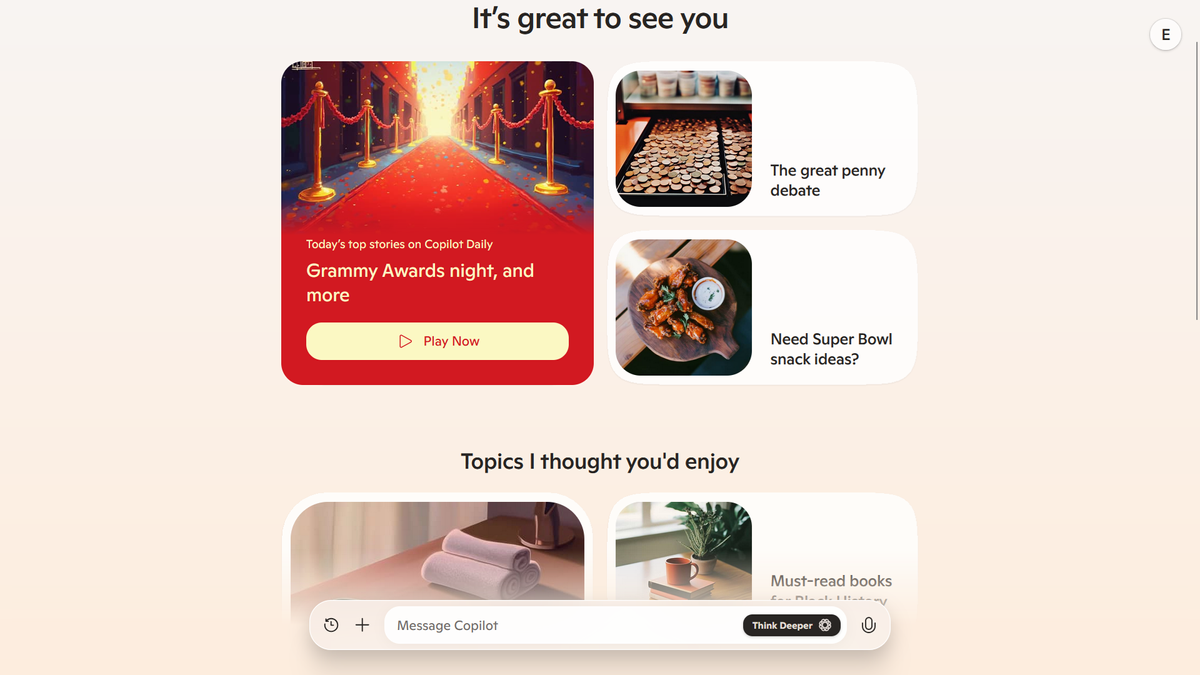Microsoft’s integration of OpenAI’s o1 model into Copilot last week brought the “Think Deeper” feature to all users. Think Deeper houses OpenAI’s o1, a reasoning model capable of some pretty good reasoning capabilities and complex insights, despite taking longer than a regular AI model to respond. OpenAI launched o1 as part of ChatGPT last year, but this CoPilot integration spells the first time you can access the model for an extended period at no extra cost.
You can turn on the o1 model by clicking on the Think Deeper button before submitting the request. As for why you might want to use Think Deeper, well it gives you access to the complex reasoning and searching that OpenAI’s o1 model is capable of, and also offers enormous improvements in terms of memory. Where standard Copilot models tend to forget quickly, the Think Deeper mode keeps track of what you request and the context throughout your conversation.
AI interior design
To put the model through its paces, I started with a somewhat straightforward request that had some wrinkles. I asked, “I want to renovate my small bedroom on a budget of $500. Can you suggest cost-effective ways to improve its look and functionality?”
The AI came back with not only a budget breakdown for different ideas, but detailed suggestions for paint colors, lighting, furniture, and personal items. It even offered ideas for cost-free changes like scents and sounds before capping off with questions to consider, a bit of philosophy, and a Frank Lloyd Wright inspirational anecdote.
Travel time

For my next query, I went a little broader and more complex, asking Copilot, “I’m planning a 5-day trip to London on a $2,500 budget. Can you help me plan an itinerary that includes must-see attractions, affordable lodging, and transportation tips?”
The response was a lot like talking to a travel agent, one who wanted to “craft a journey where every moment immerses you in the heartbeat of this vibrant city, all while keeping your wallet happy.” The AI then set up a whole itinerary, with each day its own theme, like “The Royal Welcome” and “East London’s Edge.” Each had the day mapped out with things to do, their prices, ideas for where to eat and stay, and approximate costs. Were I planning such a trip as a first-timer to London, I could think of a lot worse as an outline to use before I left.
Notably, as with the redecorating request, Copilot became very philosophical again at the end, keeping up the travel agent theme by reminding me that “Travel is more than ticking off landmarks; it’s about the moments that resonate with your own journey. Perhaps you’d love an afternoon sketching by the Thames, delving into quirky bookstores, or finding the perfect spot to watch the city’s skyline light up.”
Playing Cupid

For my last experiment, I went as simple as possible and asked Copilot to describe a perfect first date. As you can see above, the response is phrased in a very human style. Most notably, the AI remembered my earlier mention of DIY projects at home and decided to incorporate them into all of the date ideas. Whether these would actually be good first dates is debatable, but at least the AI is paying attention and remembering our earlier chat.
Copilot without the o1 model is definitely quicker but usually shallower as well. That’s great for simple tasks but can mean there’s a need for a lot of manual tweaking. Copilot with o1 is smarter, more thoughtful, and much better at maintaining context, but it sometimes gets lost in its own brilliance. That said, it does feel more like an actual AI collaborator. So, if you need deep AI-powered insights, asking Copilot to Think Deeper is a great idea. Just don’t use it when you’re in a hurry, because in those circumstances, a brilliant overthinker is not ideal.






